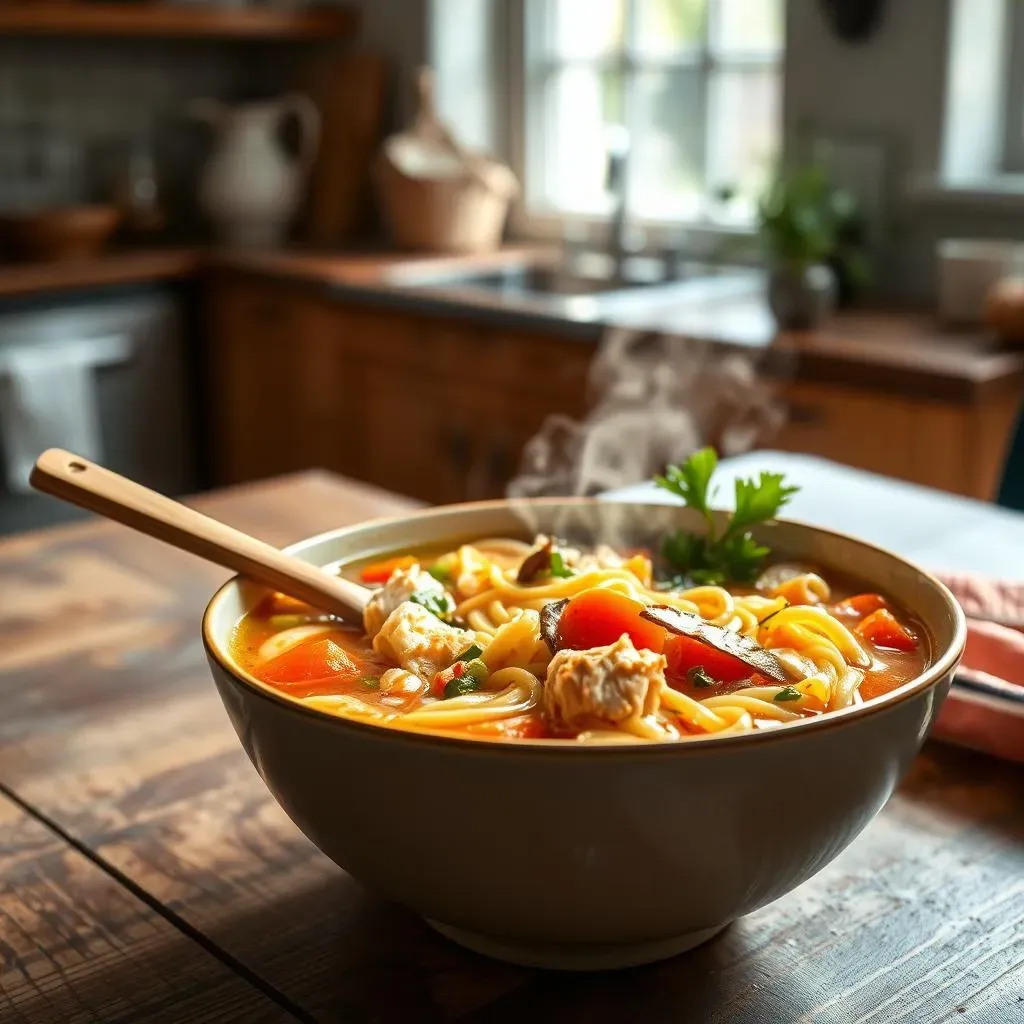Table of Contents
Craving a warm, comforting bowl of chicken noodle soup but watching your sodium intake? You're not alone! Many store-bought canned soups are loaded with sodium, making them a no-go for those on a low-sodium diet. But don't despair! This article dives into a delicious and easy-to-make low sodium chicken noodle soup recipe that will satisfy your cravings without compromising your health. We'll explore why making your own soup is a game-changer, comparing sodium levels to those found in typical canned varieties. Then, we'll walk you through crafting the perfect bowl, from selecting the right ingredients and mastering cooking techniques, to using an Instant Pot for a quick and convenient meal. Plus, we'll share serving suggestions and tips for storing, reheating, and freezing your homemade soup so you can enjoy it anytime. Get ready to rediscover the joy of chicken noodle soup, the healthy way!
Why Make Your Own Low Sodium Chicken Noodle Soup?
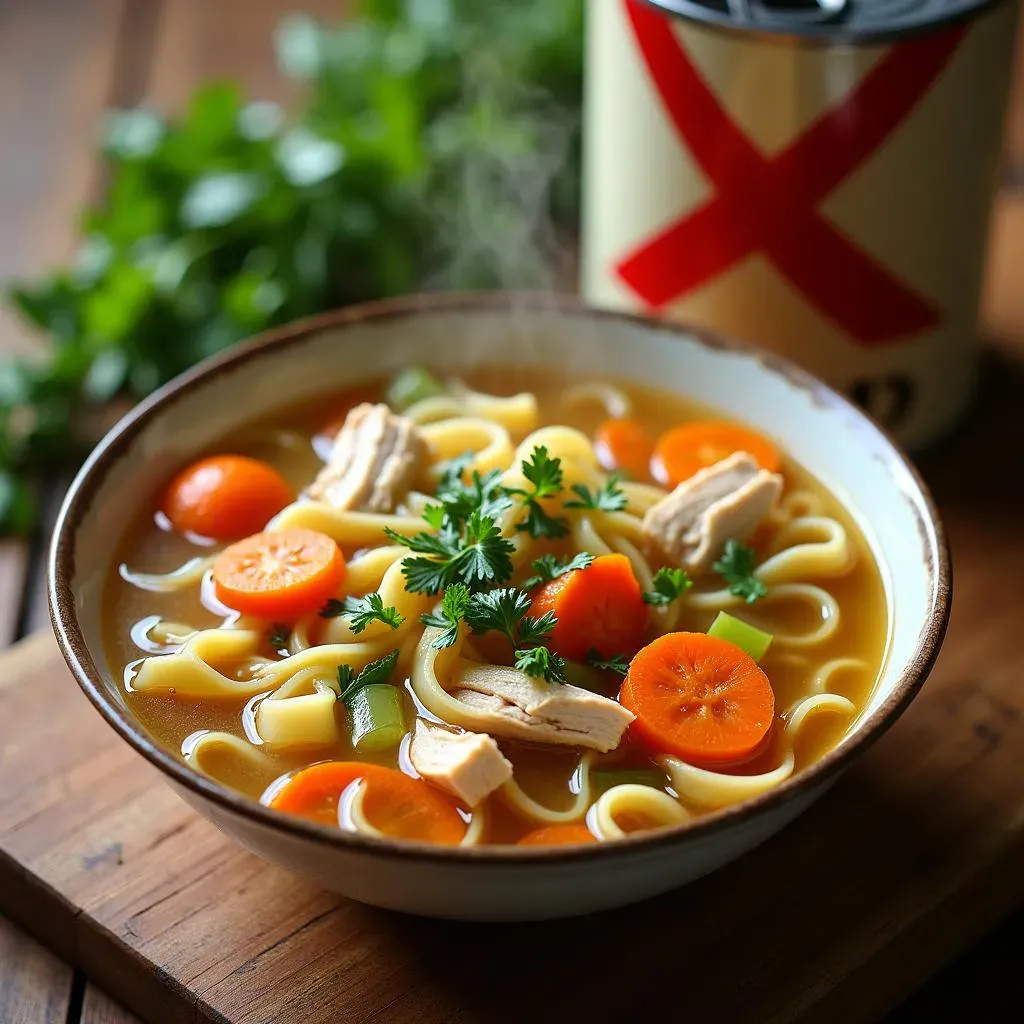
Why Make Your Own Low Sodium Chicken Noodle Soup?
#1: Control the Sodium, Control Your Health
Let's face it, canned chicken noodle soup is a sodium bomb. Seriously, check the label sometime. You'll be shocked. One cup can pack almost a thousand milligrams of sodium! That's nearly half the daily recommended intake for someone on a low-sodium diet. When you make your own, you're in the driver's seat. You decide exactly how much (or how little!) sodium goes in. This is especially important if you're managing high blood pressure, heart disease, or other health conditions that require sodium restriction. It's about taking control of what you're putting into your body and nourishing yourself with intention.
Think of it this way: you wouldn't let someone else dictate what kind of fuel goes into your car, would you? Your body is the same – it deserves the best! Making your own low-sodium soup is like choosing premium fuel for your engine. You're giving it the nutrients it needs without the unnecessary and harmful additives.
#2: Freshness You Can Taste (and Feel Good About)
Beyond the sodium issue, homemade soup just tastes better. Period. You're using fresh ingredients, like plump chicken, vibrant veggies, and aromatic herbs. Compare that to the processed, sometimes mushy ingredients you find in canned soup. The difference is night and day. It is also important to consider that most canned soup use preservatives, which can be avoided when making your own at home. Knowing exactly what goes into your soup gives you peace of mind and allows you to customize the flavors to your liking.
Imagine the aroma of simmering chicken and vegetables filling your kitchen. That's an experience you just can't get from opening a can. Plus, cooking is a form of self-care. It's a chance to slow down, be creative, and nourish yourself from the inside out. And let's be honest, there's something incredibly satisfying about creating a delicious and healthy meal from scratch.
Crafting the Perfect Low Sodium Chicken Noodle Soup Recipe: Ingredients & Techniques
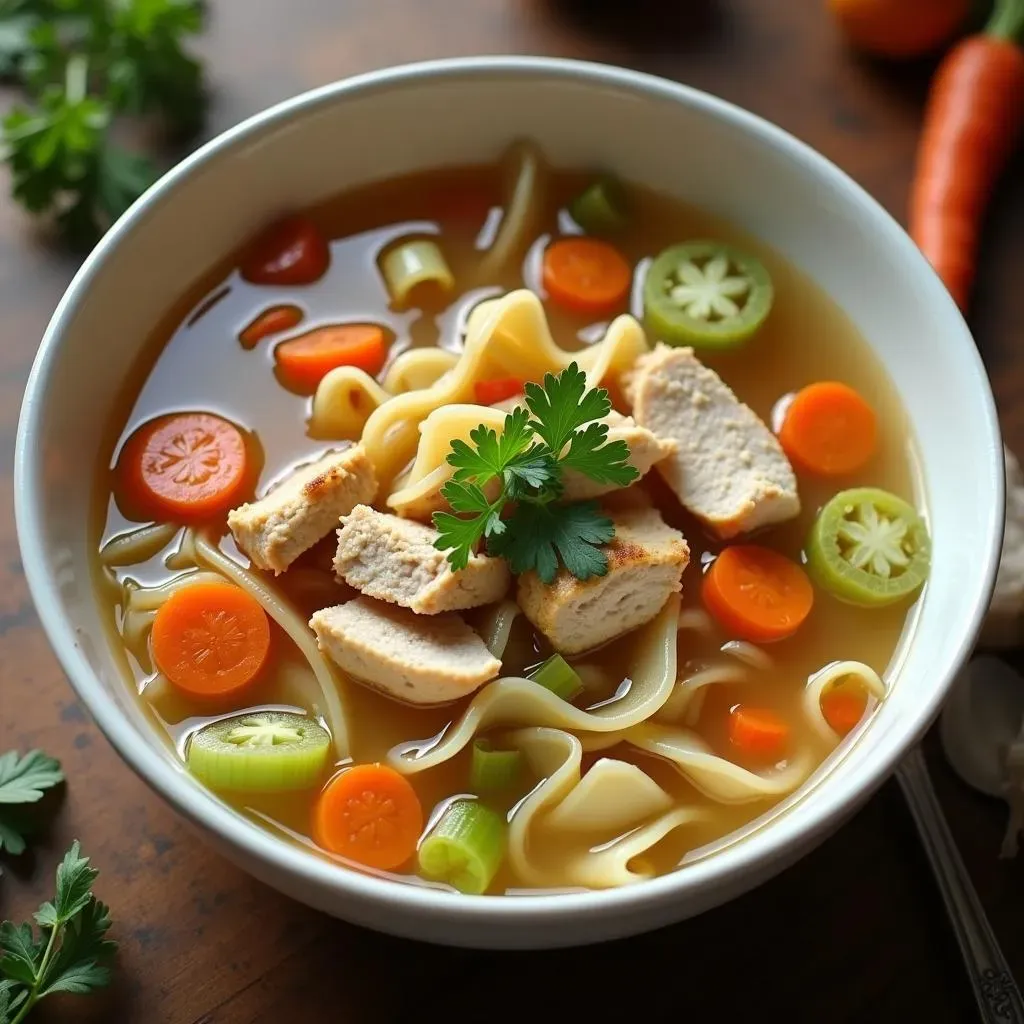
Crafting the Perfect Low Sodium Chicken Noodle Soup Recipe: Ingredients & Techniques
#1: The Broth is Boss: Choosing Low Sodium Options
The foundation of any good chicken noodle soup is, of course, the broth. This is where most of the sodium hides in store-bought versions. The key is to start with a low sodium or no-salt-added chicken broth. You can find these at most grocery stores, but be sure to read the labels carefully! Even "low sodium" options can sometimes be surprisingly high in sodium. If you're feeling ambitious, you can even make your own chicken broth from scratch. This gives you complete control over the ingredients and sodium content.
Another trick is to use a combination of low-sodium broth and water. This dilutes the sodium further without sacrificing too much flavor. You can also boost the flavor with other ingredients like herbs, spices, and vegetables. Don't be afraid to experiment and find what works best for your taste!
#2: Flavor Boosters: Herbs, Spices, and Veggies to the Rescue
So, you've got your low-sodium broth. Now what? It's time to load up on flavor! This is where herbs, spices, and vegetables come in. These ingredients not only add depth and complexity to your soup but also help compensate for the lack of salt.
Some of my favorite flavor boosters include:
- Fresh herbs: Parsley, thyme, rosemary, and bay leaf are all great choices.
- Dried spices: Garlic powder, onion powder, paprika, and black pepper can add a lot of flavor.
- Aromatics: Onions, carrots, and celery are essential for a classic chicken noodle soup flavor. Sautéing them before adding the broth helps to develop their sweetness.
- Other vegetables: Mushrooms, zucchini, and spinach can add extra nutrients and flavor.
Don't be afraid to get creative and experiment with different combinations of herbs, spices, and vegetables. The possibilities are endless!
#3: Chicken and Noodles: Choosing the Right Cuts and Pasta
Of course, it wouldn't be chicken noodle soup without the chicken and noodles! When it comes to chicken, you have a few options. You can use boneless, skinless chicken breasts or thighs, or you can use a whole chicken. Using a whole chicken will give you the most flavor, as the bones and skin add richness to the broth. However, it also takes longer to cook. If you're short on time, boneless, skinless chicken breasts or thighs are a good option. Just be sure not to overcook them, or they will become dry.
For noodles, egg noodles are the classic choice. They have a great texture and flavor that complements the chicken and broth. However, you can use any type of pasta you like. Just be aware that different types of pasta will cook at different rates. Also, keep in mind that noodles absorb liquid as they sit in the soup, so you may need to add more broth when reheating.
Ingredient | Low-Sodium Tip |
|---|---|
Chicken Broth | Always choose "no salt added" or "low sodium" varieties. Homemade is best! |
Chicken | Use fresh, unseasoned chicken. Avoid pre-cooked or processed chicken. |
Noodles | Cook noodles separately and add them to the soup just before serving to prevent them from absorbing too much liquid. |
Vegetables | Use fresh or frozen vegetables without added salt. |
Herbs & Spices | Load up on fresh and dried herbs and spices to boost flavor without salt. |
Instant Pot Low Sodium Chicken Noodle Soup: A Quick & Easy Method
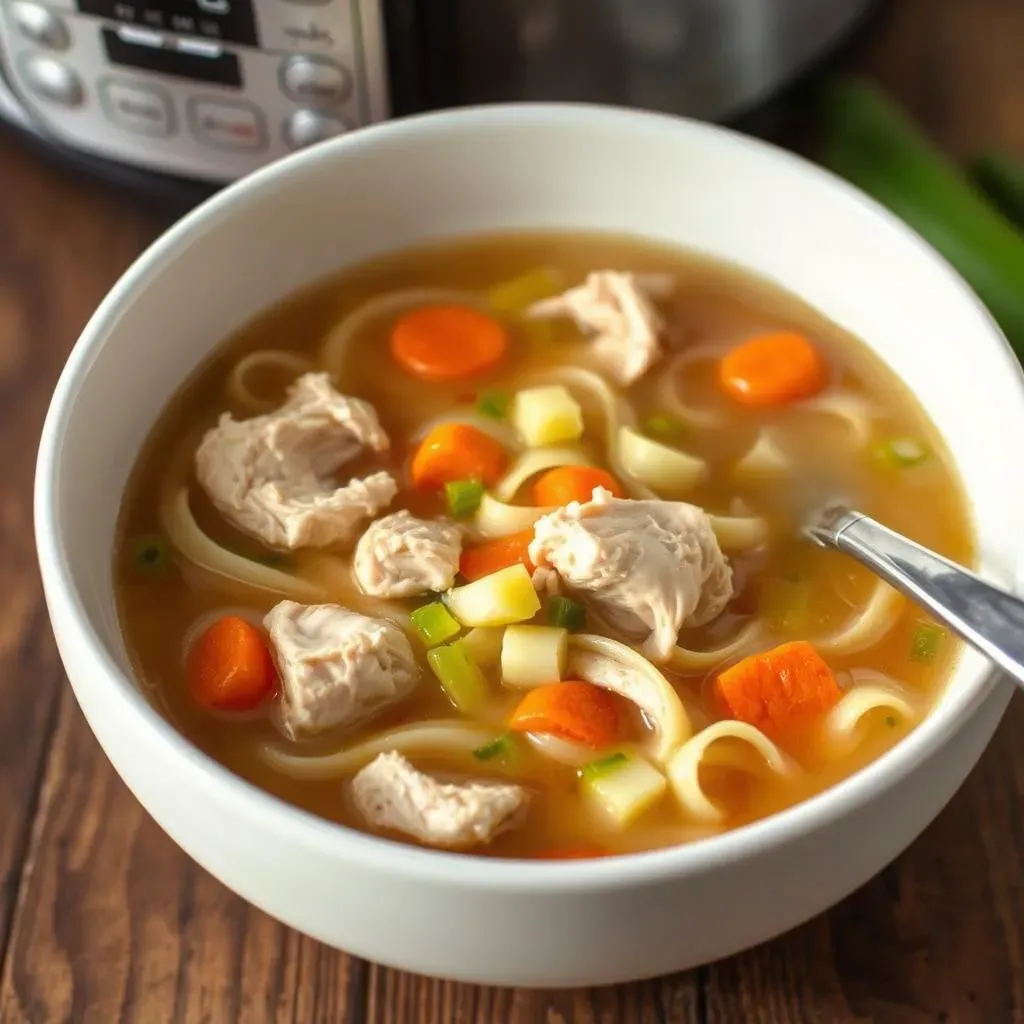
Instant Pot Low Sodium Chicken Noodle Soup: A Quick & Easy Method
Why the Instant Pot is Your New Best Friend
let's talk Instant Pot. If you're not already obsessed, you're about to be. Seriously, this thing is a game-changer for busy weeknights. For low sodium chicken noodle soup, it's a dream come true. You get all the delicious, comforting flavors of a slow-cooked soup in a fraction of the time. We're talking about going from raw ingredients to a steaming bowl of goodness in under an hour. Plus, the Instant Pot helps to intensify the flavors, making your low-sodium soup taste even richer and more satisfying.
Think of it as a flavor-infusing time machine. It locks in all the goodness and creates a depth of flavor that's hard to achieve with other methods. No more babysitting the stove for hours! Just set it and forget it (well, almost).
Step-by-Step: Instant Pot Low Sodium Chicken Noodle Soup
Alright, let's get down to the nitty-gritty. Here's a basic rundown of how to make low sodium chicken noodle soup in your Instant Pot. Remember to adjust the quantities and ingredients to your liking. The beauty of homemade soup is that it's totally customizable!
- Sauté: Turn on the Instant Pot's sauté function and add a little olive oil. Sauté your onions, carrots, and celery until they're softened. This step builds a base of flavor.
- Add Chicken: Add your chicken (either whole or cut into pieces) to the pot and brown it on all sides. This adds another layer of flavor.
- Add Broth and Seasonings: Pour in your low-sodium chicken broth and add your herbs and spices. Don't be shy!
- Pressure Cook: Close the lid and set the Instant Pot to pressure cook on high for the appropriate time (usually 8-10 minutes for chicken breasts or thighs, longer for a whole chicken).
- Release Pressure: Let the pressure release naturally for 10-15 minutes, then quick-release any remaining pressure.
- Shred Chicken: Remove the chicken from the pot and shred it with two forks.
- Add Noodles: Add your noodles to the pot and cook until they're tender (usually 5-7 minutes).
- Return Chicken: Return the shredded chicken to the pot.
- Serve: Ladle into bowls and enjoy!
Pro Tip: For even more flavor, use bone-in, skin-on chicken pieces. The bones and skin add richness to the broth. Just be sure to remove the skin before serving if you're watching your fat intake.
Tips and Tricks for Instant Pot Success
Want to take your Instant Pot low sodium chicken noodle soup to the next level? Here are a few extra tips and tricks:
- Don't Overfill: Never fill your Instant Pot more than two-thirds full. This can cause pressure-related issues.
- Adjust Cooking Time: Cooking times may vary depending on your Instant Pot model and the size of your chicken pieces. Always check the internal temperature of the chicken to ensure it's cooked through.
- Prevent the "Burn" Notice: To prevent the dreaded "burn" notice, make sure there's enough liquid in the pot and that nothing is stuck to the bottom. Deglazing the pot after sautéing can also help.
- Add Veggies Later: If you like your vegetables crisp-tender, add them towards the end of the cooking time. Otherwise, they may become mushy.
With a little practice, you'll be whipping up delicious and healthy low sodium chicken noodle soup in your Instant Pot in no time. Trust me, your taste buds (and your body) will thank you!
Serving Suggestions: What to Eat with Your Low Sodium Chicken Noodle Soup
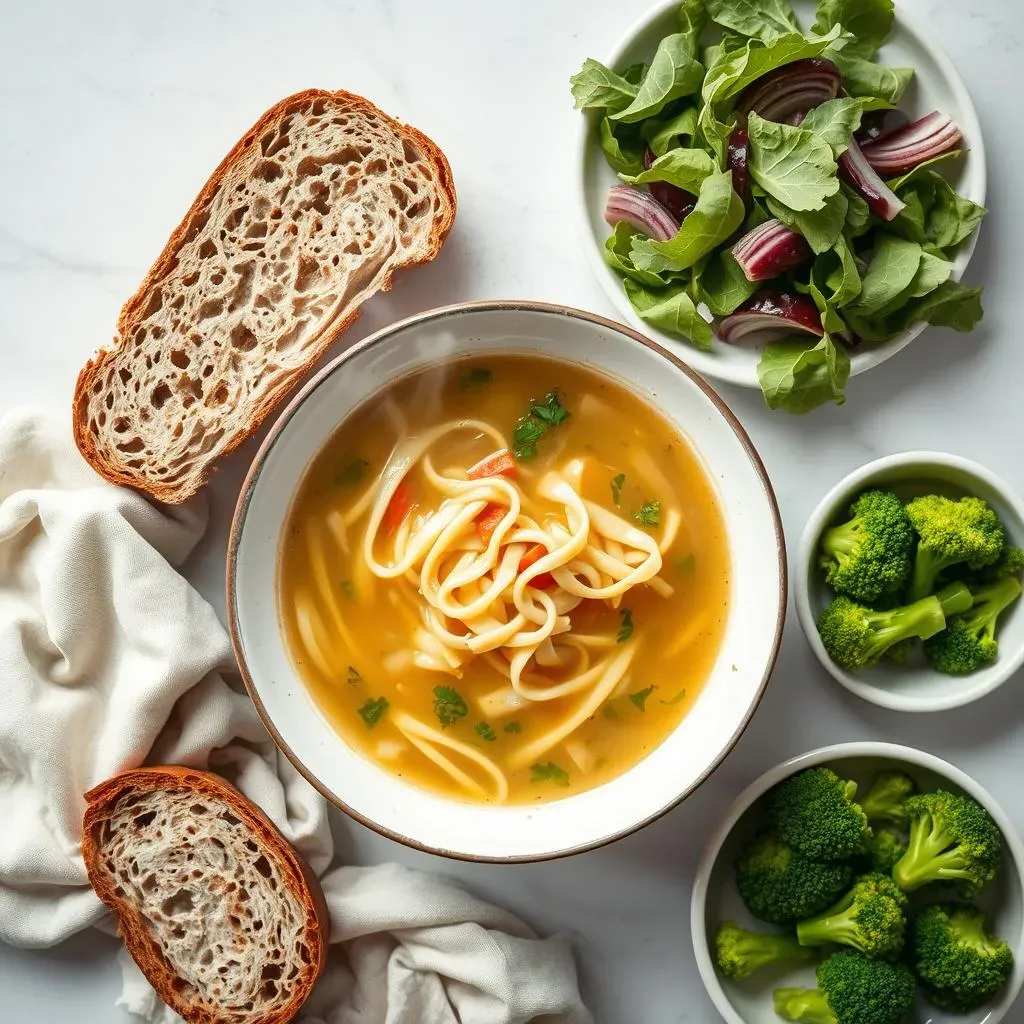
Serving Suggestions: What to Eat with Your Low Sodium Chicken Noodle Soup
#1: Light and Fresh: Salads that Complement
Chicken noodle soup is often a hearty and comforting meal, so pairing it with a light and fresh salad can create a balanced and satisfying experience. Think crisp greens, juicy tomatoes, and a tangy vinaigrette. A simple cucumber and dill salad is also a fantastic option, as the cool flavors contrast nicely with the warmth of the soup. The goal is to add a refreshing element that doesn't overpower the main course. Avoid heavy, creamy dressings, as they can be high in sodium and fat. Instead, opt for a homemade vinaigrette with olive oil, vinegar, and a touch of honey or maple syrup.
Consider adding some protein to your salad, such as grilled chicken or chickpeas, to make it a more substantial meal. You can also add some crunchy elements, like toasted nuts or seeds, for added texture and flavor. Remember to keep the sodium content in mind when choosing your salad ingredients and dressings. Look for low-sodium options or make your own from scratch.
#2: Bread on the Side: Low Sodium Options
A slice of warm bread is a classic accompaniment to chicken noodle soup. But store-bought bread can often be surprisingly high in sodium. The solution? Make your own! Homemade bread is not only delicious but also allows you to control the ingredients and sodium content. There are many easy low-sodium bread recipes available online, or you can simply adapt your favorite recipe by reducing the amount of salt. Another option is to look for low-sodium bread at your local bakery or grocery store. Be sure to read the labels carefully, as sodium content can vary widely.
If you don't have time to bake your own bread, consider serving your soup with some whole-wheat crackers or rice cakes. These are generally lower in sodium than bread and can still provide a satisfying crunch. You can also toast the crackers or rice cakes for added flavor and texture.
#3: Beyond the Basics: Creative Pairings
While salads and bread are classic accompaniments to chicken noodle soup, don't be afraid to get creative and experiment with other pairings. For example, a grilled cheese sandwich made with low-sodium cheese is a delicious and comforting option. You can also try serving your soup with some steamed vegetables, such as broccoli or green beans, for an extra dose of nutrients. Or, if you're feeling adventurous, try pairing your soup with a small portion of quinoa or brown rice. These grains add a nutty flavor and chewy texture that complements the soup nicely.
Another idea is to garnish your soup with some fresh herbs, such as parsley or chives. This adds a pop of color and flavor. You can also add a squeeze of lemon juice for a bright and tangy finish. Ultimately, the best side dish for your low sodium chicken noodle soup is one that you enjoy and that fits your dietary needs. So, don't be afraid to experiment and find what works best for you!
Side Dish | Low-Sodium Tip |
|---|---|
Salad | Use a homemade vinaigrette with low-sodium ingredients. |
Bread | Bake your own low-sodium bread or look for low-sodium options at the store. |
Grilled Cheese | Use low-sodium cheese and whole-wheat bread. |
Steamed Vegetables | Steam vegetables without adding salt. |
Quinoa or Brown Rice | Cook grains in water without added salt. |
Storing, Reheating, and Freezing Your Homemade Low Sodium Chicken Noodle Soup
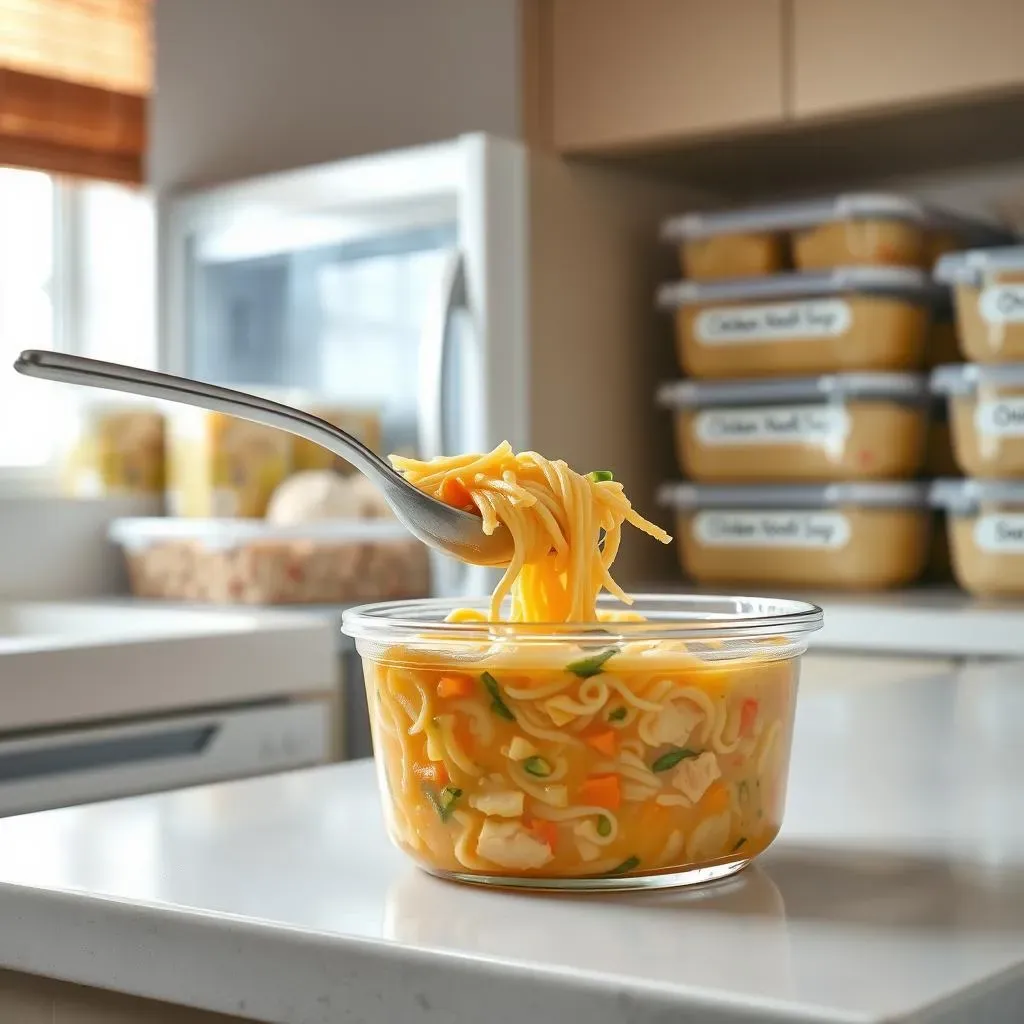
Storing, Reheating, and Freezing Your Homemade Low Sodium Chicken Noodle Soup
#1: Safe and Sound: Proper Storage Techniques
you've made a big batch of delicious low sodium chicken noodle soup. Now what? Proper storage is key to keeping it fresh and safe to eat. The first rule of thumb is to cool the soup down quickly. Don't leave it sitting on the counter for hours! This can allow bacteria to grow. Instead, transfer the soup to shallow containers and refrigerate it as soon as possible. Shallow containers help the soup cool down faster. Once the soup is cooled, cover the containers tightly to prevent it from drying out and absorbing odors from the refrigerator.
In the refrigerator, your low sodium chicken noodle soup will last for 3-4 days. Be sure to label the containers with the date so you know when it was made. When you're ready to eat it, check for any signs of spoilage, such as a sour smell or slimy texture. If in doubt, throw it out!
#2: Reheating 101: Maintaining Flavor and Texture
Reheating your low sodium chicken noodle soup is easy, but there are a few things to keep in mind to maintain its flavor and texture. The best way to reheat soup is on the stovetop over medium heat. Stir it occasionally to prevent it from sticking to the bottom of the pot. If the soup is too thick, add a little water or low-sodium broth to thin it out. You can also reheat soup in the microwave, but be sure to use a microwave-safe container and heat it in intervals, stirring in between, to prevent it from splattering.
One thing to note is that the noodles in your soup will continue to absorb liquid as they sit. This means that your soup may be thicker after it's been refrigerated. Don't worry, this is normal! Just add a little more water or low-sodium broth when reheating to achieve your desired consistency. You may also want to add a few fresh herbs or spices to brighten up the flavor after reheating.
Storage Method | Tips for Success |
|---|---|
Refrigerating | Cool quickly in shallow containers, store for 3-4 days. |
Reheating on Stovetop | Heat over medium, stir occasionally, add liquid if needed. |
Reheating in Microwave | Use microwave-safe container, heat in intervals, stir in between. |
Freezing | Cool completely, use freezer-safe containers, leave headspace. |
#3: Freeze for Later: Extending the Shelf Life
Want to keep your low sodium chicken noodle soup on hand for longer than a few days? Freezing is the answer! Frozen soup can last for 2-3 months without losing too much flavor or quality. The key to successful freezing is to cool the soup completely before transferring it to freezer-safe containers. Leave some headspace in the containers, as the soup will expand as it freezes. You can use plastic containers, glass jars, or freezer bags to store your soup. If using freezer bags, lay them flat in the freezer to save space.
When you're ready to eat your frozen soup, thaw it in the refrigerator overnight or in a pot of cold water. Once thawed, reheat it as you would refrigerated soup. Keep in mind that the noodles may be a bit softer after freezing and thawing. If you're concerned about the texture of the noodles, you can cook them separately and add them to the soup after it's been reheated. This will help them maintain their firmness.
Conclusion: Slurping Your Way to Health
So, ditch those sodium-laden cans and embrace the deliciousness of homemade! This low sodium chicken noodle soup recipe is more than just a meal; it's a step towards a healthier lifestyle, without sacrificing flavor. Whether you're a seasoned cook or just starting out, this recipe is adaptable and forgiving. Experiment with different herbs and spices to find your perfect blend, and don't be afraid to get creative with your side dishes. With a little planning and some simple ingredients, you can enjoy a comforting bowl of chicken noodle soup that's both good for your body and soul. Now go forth and create some soup magic!
